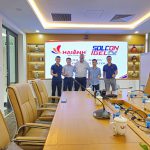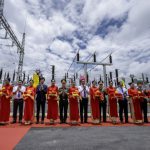- GIẢI PHÁP SẠC XE Ô TÔ ĐIỆN NVCharge
- DANFOSS
- NĂNG LƯỢNG TÁI TẠO
- GIẢI PHÁP TÍCH HỢP
- Hệ thống biến tần trung, hạ áp
- Hệ thống cân băng tải
- Hệ thống chuyển nguồn điện tự động ATS
- Hệ thống điều khiển động cơ MCC
- Hệ thống điều khiển phân tán DCS
- Hệ thống điều khiển PLC - Scada
- Hệ thống điều khiển TPS
- Hệ thống giám sát và nhiệt trị than online
- Hệ thống khởi động mềm trung, hạ áp
- Hệ thống UPS
- Tủ điện phân phối MDB & DB, tủ cấp nguồn
- MARECHAL - TECHNOR
- BORRI
- FLENDER
- DURAG
- SOLCON
- SIEMENS
- METSO OUTOTEC
- DỊCH VỤ KỸ THUẬT
Liên hệ
CÔNG TY CỔ PHẦN THƯƠNG MẠI KỸ THUẬT HẢI ANH – HAI ANH JSC
Trụ sở tại TP Hà Nội:
+ Địa chỉ: P301, Nhà D5C, đường Trần Thái Tông, phường Cầu Giấy, TP. Hà Nội, Việt Nam
+ ĐT: (+84-24) 6269 7755
+ Fax: (+84-24) 6269 5556Trung tâm nghiên cứu, sản xuất công nghệ cao Nova Energy:
Lô đất CN1-12B – 1.3, Khu công nghiệp công nghệ cao 1, Khu Công nghệ cao Hòa Lạc, xã Hạ Bằng, Hà Nội, Việt Nam
+ ĐT: (+84-24) 3202 2677Chi nhánh tại miền Trung:
+ Địa chỉ: P1109, Toà A, chung cư Tecco Đông vệ, phường Hạc Thành, tỉnh Thanh Hoá, Việt Nam
+ ĐT: (+84-23) 7383 8886Chi nhánh tại miền Nam:
+ Địa chỉ: Tầng 1, Tòa nhà Gia Thy, 158 Đào Duy Anh, phường Đức Nhuận, Thành phố Hồ Chí Minh, Việt Nam
+ ĐT: (+84-28) 3517 8949
+ Fax: (+84-28) 3517 8950-

Giải pháp sạc xe điện NVCharge có mặt tại Không gian công nghệ cao – Hội chợ Mùa Thu 2025
-

Hải Anh đón tiếp ông Izzi Eicher – Đại diện hãng Solcon (Israel) đến thăm và làm việc tại Nhà máy
-

Hải Anh Nhận Giải Thưởng “Market Expansion Award” tại Innomotics Academy 2025
-

KHÁNH THÀNH DỰ ÁN NHÀ MÁY ĐIỆN GIÓ HẢI ANH TẠI QUẢNG TRỊ
-

Hải Anh Cháy Hết Mình, Gắn Kết Yêu Thương Tại Miền Trung Thân Yêu! ❤️🔥
Danh mục sản phẩm
Tin tức mới
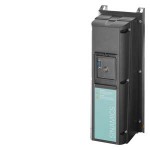
SINAMICS G120P and G120P Cabinet pump, fan, compressor inverters
SINAMICS G120P and G120P Cabinet pump, fan, compressor inverters Overview Introduction SINAMICS G120P and SINAMICS G120P Cabinet pump, fan and compressor inverters SINAMICS G120P, built-in and wall-mounted units in degrees of protection IP20, IP54 and IP55 CU230P‑2 Control Units PM230 Power Modules, 0.37 kW to 90 kW PM240 Power Modules, 90 kW to 132 kW PM330 Power Modules, 160 kW to 400 kW Supplementary system components Spare parts SINAMICS G120P Cabinet, cabinet units in degrees of protection from IP20 to IP54 SINAMICS G120P Cabinet, 110 kW to 400 kW The SINAMICS G120P is Ideal for building automation, water and process industries. It has been specially designed for the industrial environment as well as for applications in heating, ventilation, and air-conditioning. The SINAMICS G120P is a cost-effective, efficient, and easy-to-operate frequency inverter for pumps, fans, and compressors with a wide range of functions. SINAMICS G120P is build up as a modular inverter system consisting of Control Unit, Power Modul, and Operator Panel (IOP = Intelligent Operater Panel, or BOP-2 = Basic Operator Panel) or blanking plate. The Control Unit supports communications to a local control as well as to monitoring devices and equipment. Depending on the degree of protection the power module supplies motors in a power range from 0.37 kW up to 400 kW (0.5 hp up to 500 hp).

SINAMICS G120C compact inverters
SINAMICS G120C compact inverters Overview Introduction SINAMICS G120C compact inverters Line-side components DC link components Load-side power components Supplementary system components Spare parts SINAMICS G120C has been especially designed for machine manufacturers who are looking for an economic, space-saving and easy-to-operate frequency converter providing a multitude of functions. This device combines in particular compactness with superior power density and is characterized by fast installation and commissioning, user-friendly connections resp. easy-to-use commissioning tools. With its three frame sizes, it covers a performance range of 0.55 kW to 18.5 kW. The energy-efficient device serves the most common communication interfaces and is an integral part of Totally Integrated Automation.
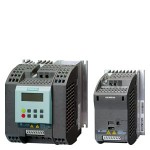
SINAMICS G110 standard inverters
SINAMICS G110 standard inverters SINAMICS G110 is an inverter with basic functions for a wide range of industrial drive applications with variable speeds. The extremely compact SINAMICS G110 inverter operates with voltage-frequency control from 200 V to 240 V on single-phase line supply systems. It is the ideal “price-conscious” inverter solution in the lower power range of the SINAMICS product family. The following line-side power components are available for SINAMICS G110 inverters: EMC filters Line reactors Fuses Circuit breaker The accessories listed below are also available: Operator panel Mounting accessories Commissioning tool Benefits Simple installation, configuration, and commissioning Robust EMC design Extensive parameter range enables configurations for a wide range of applications Simple cable connection Scalable functionality with analog and USS versions Quiet motor operation as a result of the high pulse frequency Status information and alarms via the optional BOP (Basic Operator Panel) Rapid copying of parameters via the optional BOP External options for PC communication and BOP Fast response time of the digital inputs with a high degree of reproducibility for applications demanding fast responses Precise setpoint input using a high-resolution 10-bit analog input (analog versions only) LED for status information Variants with integrated EMC filter class A or B DIP switches for easy adaptation to 50 Hz or 60 Hz applications DIP switches for simple bus termination for the USS version (RS485) Bus-capable serial RS485 interface (USS versions only) enables integration into a networked drive system 2/3-wire method (pulsed/maintained signals) for universal control via digital inputs Adjustable lower voltage limit for the DC link to ensure controlled motor braking if the power fails Accessories (overview) BOP operator panel Adapter for mounting on DIN rails (frame sizes FSA and FSB) PC inverter connection kit STARTER commissioning tool Line-side power components (overview) EMC filter, class B with low leakage currents (additionally available for inverters with integrated filter) EMC filter, class B (additionally available for inverters with integrated filter) Line reactors International standards Fulfills the requirements of the EU low-voltage guideline CE marking Certified to UL and cUL C-Tick
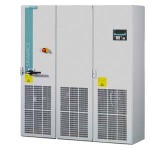
SINAMICS S150
SINAMICS S150 Overview SINAMICS S150 Converter Cabinet Units are particularly suitable for all variable-speed single-axis drives with high performance requirements, i.e., drives with: high dynamic requirements frequent braking cycles and high braking energy levels four-quadrant operation SINAMICS S150 offers high-performance speed control with excellent accuracy and a high dynamic response. The following voltages and power ratings are available: Line voltage Type rating 380 … 480 V 3 AC 110 … 800 kW 500 … 690 V 3 AC 75 … 1200 kW Degrees of protection are IP20 (standard), and as an option IP21, IP23, IP43 and IP54. Line and motor-side components as well as additional monitoring devices can be installed in the converter cabinet units. A wide range of electrical and mechanical components enable the drive system to be optimized individually to suit customer requirements.
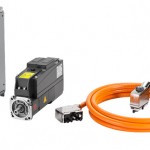
SINAMICS S120M distributed servo drive
SINAMICS S120M is the distributed version of the modular SINAMICS S120 drive system. This drive is a compact and turnkey drive unit
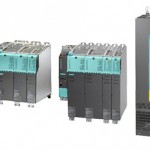
SINAMICS S120 built-in devices
SINAMICS S120 built-in devices Overview Flexibility for successful machine concepts As part of the SINAMICS drive family, the SINAMICS S120 drive is a modular system for high-performance applications in machine and plant engineering. SINAMICS S120 offers high-performance single-axis and multi-axis drives for a very broad range of industrial applications. By virtue of its scalability and flexibility, SINAMICS S120 is the ideal system for satisfying the ever increasing demand for more axes and better performance. SINAMICS S120 supports flexible machine designs and speedy implementation of customized drive solutions. The response to ever increasing demands Modern machines must be built at ever lower cost, but deliver ever greater productivity. The SINAMICS S120 drive concept meets both these challenges! It is easy to configure and thus helps to reduce project completion times. Its excellent dynamic response and accuracy permit higher cycle rates for maximum productivity. Applications in machine and plant engineering Regardless of whether the application involves continuous material webs or cyclic, highly dynamic processes – SINAMICS S120 means increased machine performance in many industries: Packaging machines Plastics processing machines Textile machines Printing machines Paper machines Hoists and cranes Handling and assembly systems Machine tools Rolling mills Test stands Renewable energy Modularity for mechanical engineering SINAMICS S120 is designed to allow free combination of power and control performance. Multi-axis drives with higher-level motion control can be implemented with the SINAMICS S120 modular system as easily as single-drive solutions. Greater flexibility with central control intelligence On the SINAMICS S120, the drive intelligence is combined with closed-loop control functions into Control Units. These units are capable of controlling drives in Vector, Servo and V/f modes. They also perform the speed and torque control functions plus other intelligent drive functions for all axes on the drive. Free performance selection for Vector and Servo control modes The use of a SINAMICS S120 Vector control is recommended for drive solutions with continuous material webs, for example, wire-drawing machines, film and paper machines, as well as for hoisting gear, centrifuges and marine drives with harmonic, circular motion. Servo control with SINAMICS S120 is employed for cyclic processes with precise, highly dynamic position control and servo motors, e.g. in textile, packaging, printing machines and machine tools. SINAMICS S120 – functions for better efficiency Basic functions: Speed control, torque control, positioning functions Intelligent starting functions for independent restart after power supply interruption BICO technology with interconnection of drive-related I/Os for easy adaptation of the drive system to its operating environment Integrated safety functions for rational implementation of safety concepts Regulated infeed/regenerative feedback functions for preventing undesirable reactions on the supply, allowing recovery of braking energy and ensuring greater stability against line fluctuations. DRIVE-CLiQ – the digital interface between all components All SINAMICS S120 components, including the motors and encoders, are interconnected by a shared serial interface called DRIVE‑CLiQ. The standardized cables and connectors reduce the variety of different parts and cut storage costs. Converter boards (Sensor Modules) for converting standard encoder signals to DRIVE‑CLiQ are available for third-party motors or retrofit applications. Swift and automatic: The electronic rating plate An important digital linkage element of the SINAMICS S120 drive system are the electronic type plates integrated in every component. They allow all drive components to be detected automatically via a DRIVE-CLiQ link. As a result, data do not need to be entered manually during commissioning or component replacement – helping to ensure that drives are commissioned successfully! The electronic rating plates of the motors contain, for example, the parameters of the electrical equivalent circuit diagram and the characteristic data of the built-in motor encoder in addition to information such as order and identification numbers. Modular design ensures flexibility and scalability DC/AC units (= Motor Modules) – available in compact booksize, booksize and chassis formats – are characterized by their modular design. All the drive intelligence is organized into Control Units. The Control Units perform all the closed-loop control functions for the drive line-up. They also handle all other drive functions such as the interconnection of drive-related I/Os, positioning functions, and feature PROFIBUS DP or PROFINET as the central interface for linking to higher-level automation systems. Line Modules function as the central energy supply to the voltage-source DC link. Line Modules are optionally available with regulated infeed/regenerative feedback to provide a constant DC link voltage and high level of supply compatibility. Motor Modules supply the motors with energy from the DC link. On AC/AC units, the infeed and motor power supply functions are combined in one device, the Power Module – available in blocksize and chassis formats. For single-axis applications, drive control functions are performed by a special Control Unit (CU310-2) mounted on the Power Module and for multi-axis applications, by a Control Unit (e.g. CU320-2) connected by a DRIVE-CLiQ link. In this case, a Control Unit Adapter is mounted on the Power Module in place of the Control Unit.
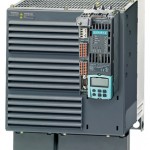
SINAMICS S110 servo drives
SINAMICS S110 servo drives SINAMICS S110 – the basic positioning drive for single-axis applications SINAMICS S110 can be used in numerous applications. Typical examples are: Handling equipment Feed and withdrawal devices Stacking units Automatic assembly machines Laboratory automation Metalworking Woodworking, glass and ceramic industries Printing machines Plastics processing machines The SINAMICS S110 servo drive is designed for connection to both synchronous servomotors and asynchronous (induction) motors. It supports all the most popular types of encoder. A variety of fieldbus interfaces is provided for linking the unit to a higher-level control system. Alternatively, it can be controlled via ±10 V and a pulse direction interface. The so-called basic positioner (EPos) is an integral component of SINAMICS S110. It provides a simple method of solving positioning tasks. Flexible in application SINAMICS S110 is a flexible, versatile system. Synchronous servomotors and asynchronous (induction) motors with outputs up to 90 kW (125 hp) can be used to implement rotary or linear axes. DRIVE-CLiQ motors can be connected simply by means of the integrated DRIVE-CLiQ interface. This means that the electronic rating plate of the motor is easy to read out, reducing the engineering time and cost involved in commissioning the drive. Furthermore, the SINAMICS S110 features an integrated encoder interface for optional use. It is capable of evaluating HTL/TTL and SSI encoders. In addition to pure point-to-point positioning, SINAMICS S110 naturally also offers on-the-fly changeover from continuous operation to positioning mode in order, for example, to precisely position objects transported randomly on a conveyor belt. Even simple traversing profiles with different motion cycles and wait times can be executed automatically by SINAMICS S110. The CU305 Control Unit of the SINAMICS S110 is equipped with an integrated communication interface for linking the inverter to an automation system. A PROFINET, PROFIBUS or CANopen interface can be ordered. Standardized protocols for linking to a higher-level control are supported – the PROFIdrive profile for positioning mode and the PROFIsafe profile for safety-related communication. The inverter is thus perfectly coordinated with the SIMATIC S7 automation system. The devices are linked by means of PROFIBUS and the SIMATIC S7 uses standard function blocks to communicate with the drive. In addition, the STARTER commissioning tool can be seamlessly integrated into STEP 7, the SIMATIC’s programming software. BICO technology Every drive contains a number of input and output variables which can be freely and independently interconnected using Binector Connector Technology (BICO). A binector is a logic signal which can assume the value 0 or 1. A connector is a numerical value, e.g. the actual speed or current setpoint. Free function blocks The drive can be adapted easily and precisely to a wide range of customized requirements using the “free function blocks” integrated in the CU305 Control Unit. The available range of blocks includes simple logic blocks such as AND/OR elements, as well as more complex devices such as smoothing elements or limit-value monitors. All blocks can be flexibly interconnected using BICO (Binector-Connector) technology, ensuring that signals are processed quickly and close to the drive which helps reduce the load on the higher-level control. Diagnostics optimally supported by trace function The time characteristics of input and output variables associated with drives can be measured by the integrated trace function and displayed using the STARTER commissioning tool. The trace can record up to 4 signals simultaneously. Recording can be triggered as a function of freely selectable boundary conditions, e.g. the value of an input or output variable. Safety Integrated The integrated safety functions of SINAMICS S110 provide highly effective application-oriented protection for personnel and machinery (terms as defined in IEC 61800-5-2). The following Safety Integrated Basic Functions are included as standard: Safe Torque Off (STO) Safe Brake Control (SBC) Safe Stop 1 (SS1) The following Safety Integrated Extended Functions are optionally available: Safe Stop 2 (SS2) Safe Operating Stop (SOS) Safely Limited Speed (SLS) Safe Speed Monitor (SSM) Safe Direction (SDI) The Safety Integrated functions are fully integrated into the drive system. They can be activated via fail-safe digital inputs on the CU305 Control Unit or via PROFINET or PROFIBUS with PROFIsafe. The Safety Integrated functions are implemented electronically and therefore offer short response times in comparison to solutions with externally implemented monitoring functions. Additional information is provided in chapter Highlights, section Safety Integrated. Accessories Memory cards The memory card can be used as an option for SINAMICS S110. The relevant slot is located underneath the CU305 Control Unit. The complete functionality of SINAMICS S110 can be saved on the memory card: the parameter settings and the firmware. When service is required, e.g. after the inverter has been replaced and the data has been downloaded from the memory card, the drive system is immediately ready for use once more. A SINAMICS Micro Memory Card (MMC) is essential, if the optional Safety Integrated Extended Functions are used. The necessary license is saved on the MMC. Intelligent Operator Panel (IOP) The IOP supports both entry-level personnel and drive experts. Thanks to the large plain text display, menu-based operation and application wizards, it is easy to commission, diagnose and locally control standard drives. The IOP can be connected to the RS232 interface of the CU305 Control Unit using the appropriate connecting cable. Mounting the IOP directly on the CU305 Control Unit is not possible. Varnished modules The following units are equipped as standard with varnished or partially varnished modules: Blocksize format units Control Units Sensor Modules The varnish coating protects the sensitive SMD components against corrosive gases, chemically active dust and moisture.
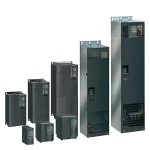
MICROMASTER 440
MICROMASTER 440 Overview Application The MICROMASTER 440 inverter is suitable for a variety of variable-speed drive applications. Its flexibility provides for a wide spectrum of applications. These also include cranes and hoisting gear, high-bay warehouses, production machines for food, beverages and tobacco, packaging machines etc.; i.e. applications which require the frequency inverter to have a higher functionality and dynamic response than usual. The inverter is especially characterized by its customer-oriented performance and ease-of-use. Its large mains voltage range enables it to be used all over the world. Design The MICROMASTER 440 has a modular design. The operator panels and the modules can be easiliy exchanged. International standards The MICROMASTER 440 inverter complies with the requirements of the EU low-voltage guideline. The MICROMASTER 440 inverter has the CE marking. Acc. to UL and c UL certified c-tick Main characteristics Easy, guided start-up Modular construction allows maximum configuration flexibility Six programmable isolated digital inputs Two scaleable analog inputs (0 V to 10 V, 0 mA to 20 mA) can also be used as a 7th/8th digital input Two programmable analog outputs (0 mA to 20 mA) Three programmable relay outputs (30 V DC/5 A, resistive load; 250 V AC/2 A, inductive load) Low-noise motor operation thanks to high pulse frequencies, adjustable (observe derating if necessary) Protection for motor and inverter Options (overview) EMC filter, Class A/B LC filter and sinusoidal filter Line commutating chokes Output chokes Gland plates Basic Operator Panel (BOP) for parameterizing the inverter Plain text Advanced Operator Panel (AOP) with multilanguage display Plain text Asian Advanced Operator Panel (AAOP) with Chinese and English display Plain text Cyrillic Advanced Operator Panel (CAOP) with Cyrillic, German and English display Communication modules PROFIBUS DeviceNet CANopen Pulse encoder evaluation module PC connection kits Mounting kits for installing the operator panels in the control cabinet doors PC start-up tools, executable under Windows 98/NT/2000/XP Professional TIA integration with Drive ES Mechanical features Modular design Operating temperature 0.12 kW to 75 kW: -10 °C to +50 °C (+14 °F to +122 °F) 90 kW to 200 kW: 0 °C to +40 °C (+32 °F to +104 °F) Compact housing as a result of high power density Easy cable connection, mains and motor connections are separated for optimum electromagnetic compatibility Detachable operator panels Screwless control terminals on detachable I/O board Performance features Latest IGBT technology Digital microprocessor control High-quality Vector Control system Flux Current Control (FCC) for improved dynamic response and optimized motor control Linear V/f characteristic Quadratic V/f characteristic Multipoint characteristic (programmable V/f characteristic) Torque control Flying restart Slip compensation Automatic restart following mains failure or fault User-definable function blocks for logic and arithmetic operations Kinetic buffering Positioning ramp down High-grade PID controller for simple internal process control (autotuning) Programmable acceleration/deceleration, 0 s to 650 s Ramp smoothing Fast Current Limit (FCL) for trip-free operation Fast, repeatable digital input response time Fine adjustment using two high-resolution 10-bit analog inputs Compound braking for controlled rapid braking Integrated brake chopper (only for 0.12 kW to 75 kW inverters) Four skip frequencies Removable “Y” capacitor for use on IT mains supplies (with non-grounded mains supplies, the “Y” capacitor must be removed, and an output choke installed) Protection features Overload capability CT mode 0.12 kW to 75 kW: Overload current 1.5 x rated output current (i.e. 150 % overload capability) for 60 s, cycle time 300 s, and 2 x rated output current (i.e. 200 % overload capability) for 3 s, cycle time 300 s 90 kW to 200 kW: Overload current 1.36 x rated output current (i.e. 136 % overload capability) for 57 s, cycle time 300 s, and 1.6 x rated output current (i.e. 160 % overload capability) for 3 s, cycle time 300 s VT mode 5.5 kW to 90 kW: Overload current 1.4 x rated output current (i.e. 140 % overload capability) for 3 s, and 1.1 x rated output current (i.e. 110 % overload capability) for 60 s, cycle time 300 s 110 kW to 250 kW: Overload current 1.5 x rated output current (i.e. 150 % overload capability) for 1 s, and 1.1 x rated output current (i.e. 110 % overload capability) for 59 s, cycle time 300 s Overvoltage/undervoltage protection Inverter overtemperature protection Special direct connection for PTC or KTY to protect the motor Earth fault protection Short-circuit protection I2t motor thermal protection Locked motor protection Stall prevention Parameter interlock
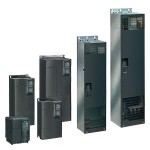
MICROMASTER 430
MICROMASTER 430 Overview Application The MICROMASTER 430 inverter is suitable for a variety of variable-speed drive applications. Its flexibility provides for a wide spectrum of applications. It is especially suitable for use with industrial pumps and fans. The inverter is especially characterized by its customer-oriented performance and ease-of-use. It has more inputs and outputs than the MICROMASTER 420, an optimized operator panel with manual/automatic switchover, and adapted software functionality. Design The MICROMASTER 430 inverter has a modular design. The operator panels and communication modules can be easily exchanged. Main characteristics Easy, guided start-up Modular construction allows maximum configuration flexibility Six programmable isolated digital inputs Two scaleable analog inputs (0 V to 10 V, 0 mA to 20 mA) can also be used as a 7th/8th digital input Two programmable analog outputs (0 mA to 20 mA) Three programmable relay outputs 30 V DC/5 A, resistive load 250 V AC/2 A, inductive load Low-noise motor operation thanks to high pulse frequencies, adjustable (observe derating if necessary) Protection for motor and inverter Control of up to three additional drives on the basis of PID control (motor staging) Operation of drive directly on mains (with external bypass circuit) Low-energy mode Detects dry run of pumps (belt failure detection) Options (overview) Line commutating chokes Output chokes LC filter and sinusoidal filter Gland plates Basic Operator Panel 2 (BOP-2) for parameterizing the inverter Communication modules PROFIBUS DeviceNet CANopen PC connection kits Mounting kits for installing the operator panels in the control cabinet doors PC start-up tools, executable under Windows 98/NT/2000/ME/XP Professional TIA integration with Drive ES International standards The MICROMASTER 430 inverter complies with the requirements of the EU low-voltage guideline. The MICROMASTER 430 inverter has CE marking. Acc. to UL and c UL certified c-tick Mechanical features Modular design Operating temperature: –10 °C to +40 °C (+14 °F to +104 °F) Compact housing as a result of high power density Easy cable connection, mains and motor connections are separated for optimum electromagnetic compatibility Detachable operator panels Screwless control terminals on detachable I/O board Performance features Latest IGBT technology Digital microprocessor control Flux Current Control (FCC) for improved dynamic response and optimized motor control Linear V/f characteristic Quadratic V/f characteristic Multipoint characteristic (programmable V/f characteristic) Flying restart Slip compensation Automatic restart facility following power failure or fault Energy saving mode (stopping e.g. of a pump at low speeds) Motor staging (connection and disconnection of additional motors, use of inverter as control drive in a pump cascade) Manual/automatic mode Load torque monitoring (belt failure detection; detects dry run of pumps) High-grade internal PID controller for simple process control Programmable acceleration/deceleration times, 0 s to 650 s Ramp smoothing Fast Current Limit (FCL) for trip-free operation Fast, repeatable digital input response time Fine adjustment using two high-resolution 10-bit analog inputs Compound braking for rapid controlled braking Four skip frequencies Removable “Y” capacitor for use on IT systems (with non-grounded mains supplies, the “Y” capacitor must be removed, and an output choke installed) Protection features Overload capability 7.5 kW to 90 kW: Overload current 1.4 x rated output current (i.e. 140 % overload capability) for 3 s and 1.1 x rated output current (i.e. 110 % overload capability) for 60 s, cycle time 300 s 110 kW to 250 kW: Overload current 1.5 x rated output current (i.e. 150 % overload capability) for 1 s and 1.1 x rated output current (i.e. 110 % overload capability) for 59 s, cycle time 300 s Overvoltage/undervoltage protection Inverter overtemperature protection Special direct connection for PTC or KTY to protect the motor Earth fault protection Short-circuit protection I2t motor thermal protection Locked motor protection Stall prevention Parameter interlock

MICROMASTER 420
MICROMASTER 420 Overview Application The MICROMASTER 420 inverter is suitable for a variety of variable-speed drive applications. It is especially suitable for applications for pumps, fans and conveyor systems. It is the ideal cost-optimized frequency inverter solution. The inverter is especially characterized by its customer-oriented performance and ease-of-use. Its large supply-voltage range enables it to be used all over the world. Design The MICROMASTER 420 has a modular design. The operator panels and communication modules can be easily exchanged without requiring any tools. Main characteristics Easy, guided start-up Modular construction allows maximum configuration flexibility Three fully programmable isolated digital inputs One scalable analog input (0 V to 10 V) can also be used as a 4th digital input One programmable analog output (0 mA to 20 mA) One programmable relay output 30 V DC/5 A, resistive load 250 V AC/2 A, inductive load Low-noise motor operation through high pulse frequency, adjustable (observe derating if necessary) Complete inverter and motor protection Options (overview) EMC filter, Class A/B LC filter Line commutating chokes Output chokes Gland plates Basic Operator Panel (BOP) for parameterizing the inverter Advanced Operator Panel (AOP) with multi-language plain text display Asian Advanced Operator Panel (AAOP) with Chinese and English plain text display Cyrillic Advanced Operator Panel (CAOP) with Cyrillic, German and English plain text display Communication modules PROFIBUS DeviceNet CANopen PC connection sets Mounting kits for installing the operator panels in the control cabinet doors PC start-up programs executable under Windows 98/NT/2000/XP Professional TIA integration with Drive ES International standards The MICROMASTER 420 inverter complies with the requirements of the EU low-voltage guideline. The MICROMASTER 420 inverter has the CE marking. Acc. to uL and cuL certified c-tick Mechanical features Modular design Operating temperature: -10 °C to +50 °C (+14 °F to +122 °F) Compact housing as a result of high power density Easy cable connection, mains and motor connections are separated for optimum electromagnetic compatibility Detachable operator panels Screwless control terminals Performance features Latest IGBT technology Digital microprocessor control Flux current control (FCC) for improved dynamic response and optimized motor control Linear V/f characteristic Quadratic V/f characteristic Multipoint characteristic (programmable V/f characteristic) Flying restart Slip compensation Automatic restart facility following mains failure or fault Internal PI controller for simple process control Programmable acceleration/deceleration, 0 s to 650 s Ramp smoothing Fast current limit (FCL) for trip-free operation Fast, repeatable digital input response time Fine adjustment using a high resolution 10-bit analog input Compound braking for rapid controlled braking Four skip frequencies Removable “Y” capacitor for use on IT systems (with non-grounded mains supplies, the “Y” capacitor must be removed and an output choke installed) Protection features Overload current 1.5 x rated output current (i.e. 150 % overload capability) for 60 s, cycle time 300 s Overvoltage/undervoltage protection Inverter overtemperature protection Motor protection using PTC via digital input (possible with supplementary circuit) Earth fault protection Short-circuit protection I2t motor thermal protection Locked motor protection Stall prevention Parameter interlock
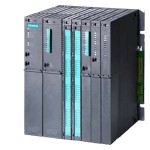
PLC Siemens S7-400
PLC Siemens S7 - 400 được thiết kế cho các giải pháp tích hợp hệ thống trong các nhà máy sản xuất và tự động hoá quá trình.
Dải sản phẩm bao gồm 9 loại tiêu chuẩn cho CPU, 2 cho dự phòng, 2 cho làm việc liên tục.
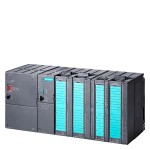
PLC Siemens S7-300
PLC Siemens S7-300 – Hệ thống mô đun PLC nhỏ cho dải đặc tính làm việc nhỏ đến trung bình – Với phạm vi mô đun có thể mở rộng nên thích nghi tối đa các nhiệm vụ tự động hóa – Sử dụng linh hoạt thông qua việc thực hiện đơn giản cấu trúc phân tán và Mạng lưới đa năng – Vận hành thân thiện người dùng và thiết kế không phức tạp – Có thể mở rộng bài toán khi nhiệm vụ điều khiển tăng lên 1. CÁC BỘ ĐIỀU KHIỂN TRUNG TÂM CPUs: CPU 312 – Nhiều cấp đầu vào trong tất cả các tác vụ của tự động hóa – Phù hợp với các ứng dụng nhỏ với các yêu cầu hiệu suất xử lý trung bình CPU 314 – Phù hợp các nhà máy với yêu cầu phạm vi chương trình trung bình – Khả năng xử lý cao bài toán nhị phân và dấu chấm động CPU 315-2DP – CPU có bộ nhớ chương trình trung bình đến lớn và số lượng kết cấu sử dụng tùy chọn trong công cụ kỹ thuật SIMATIC – Khả năng xử lý cao bài toán nhị phân và dấu chấm động – Được sử dụng như bộ điều khiển trung tâm trong dây chuyền sản xuất – Kết nối mạng truyền thông PROFIBUS DP Master/Slave – Có khả năng mở rộng vào/ra thông minh – Cấu hình cấu trúc phân tán vào/ra – Chế độ Isochronous trong PROFIBUS CPU 315-2PN/DP – CPU có bộ nhớ chương trình trung bình đến lớn và số lượng kết cấu sử dụng tùy chọn trong công cụ kỹ thuật SIMATIC – Khả năng xử lý cao bài toán nhị phân và dấu chấm động – Được sử dụng như bộ điều khiển trung tâm trong dây chuyền sản xuất – Có 2 cổng truyền thông PROFINET – Bộ điều khiển PROFINET IO để điều khiển cấu trúc vào ra phân tán trên PROFINET – Thiết bị PROFINET I kết nối với CPU như thiết bị tích hợp PROFINET dư ới một SIMATIC hoặc bộ điều khiển PROFINET IO thuộc bên thứ 3 – Bộ phận tự động hóa cơ bản trên PROFINET – PROFINET Proxy là thiết bị thông minh thuộc PFOFIBUS trong thành phần cơ bản của tự động hóa – Tích hợp web sever với các tùy chọn tạo ra các trang web do người dùng xác định – Hỗn hợp giao diện truyền thông MPI và PRIFIBUS DP CPU317-2DP – CPU có bộ nhớ chương trình trung bình đến lớn và số lượng kết cấu sử dụng tùy chọn trong công cụ kỹ thuật SIMATIC – Phù hợp với nhiệm vụ tự động hóa các ngành công nghiệp như các máy nối tiếp, máy đặc biêt, xây dựng nhà máy – Khả năng xử lý cao bài toán nhị phân và dấu chấm động – Được sử dụng như bộ điều khiển trung tâm trong dây chuyền sản xuất – Có 2 cổng truyền thông PROFINET – Có khả năng mở rộng vào/ra thông minh – Cấu hình cấu trúc phân tán vào/ra – Chế độ Isochronous trong PROFIBUS CPU 317-2PN/DP – CPU có bộ nhớ chương trình trung bình đến lớn và số lượng kết cấu sử dụng tùy chọn trong công cụ kỹ thuật SIMATIC – Phù hợp với nhiệm vụ tự động hóa các ngành công nghiệp như các máy nối tiếp, máy đặc biêt, xây dựng nhà máy – Khả năng xử lý cao bài toán nhị phân và dấu chấm động – Có 2 cổng truyền thông PROFINET – Bộ điều khiển PROFINET IO để điều khiển cấu trúc vào ra phân tán trên PROFINET – Thiết bị PROFINET I kết nối với CPU như thiết bị tích hợp PROFINET dư ới một SIMATIC hoặc bộ điều khiển PROFINET IO thuộc bên thứ 3 – Bộ phận tự động hóa cơ bản trên PROFINET – PROFINET Proxy là thiết bị thông minh thuộc PFOFIBUS trong thành phần cơ bản của tự động hóa – Tích hợp web sever với các tùy chọn tạo ra các trang web do người dùng xác định – Hỗn hợp giao diện truyền thông MPI và PRIFIBUS DP – Chế độ Isochronous trong PROFIBUS CPU 319-3PN/DP – Tốc độ xử lí câu lệnh của CPU cao, bộ nhớ chương trình rộng, số lượng khung dữ liệu phù hợp với các yêu cầu ứng dụng – Phù hợp với nhiệm vụ tự động hóa các ngành công nghiệp như các máy nối tiếp, máy đặc biêt, xây dựng nhà máy – Được sử dụng như bộ điều khiển trung tâm trong dây chuyền sản xuất – Bộ điều khiển PROFINET IO để điều khiển cấu trúc vào ra phân tán trên PROFINET – Thiết bị PROFINET I kết nối với CPU như thiết bị tích hợp PROFINET dư ới một SIMATIC hoặc bộ điều khiển bất siemens FROFINET I/O – Có 2 cổng truyền thông PROFINET – Chế độ Isochronous trong PROFIBUS – PROFINET Proxy là thiết bị thông minh thuộc PFOFIBUS trong thành phần cơ bản của tự động hóa – Tích hợp web sever với các tùy chọn tạo ra các trang web do người dùng xác định – Tích hợp vào ra phân tán trong bộ phận tự động hóa cơ bản trên PROFIBUS – Hỗ trợ tùy chọn việc sử dụng các công cụ kỹ thuật SIMATIC CPU 312C – Khối CPU tích hợp vào/ra số – Phù hợp các ứng dụng nhỏ với các yêu cầu tốc độ xử lý cao – Chức năng công nghệ CPU313C – Khối CPU tích hợp vào/ra số – Phù hợp với nhà máy có yêu cầu tốc độ xử lí cao và thời gian đáp ứng nhanh – Chức năng công nghệ CPU313C-2PtP – Khối CPU tích hợp vào/ra số cũng như giao diện nối tiếp thứ hai – Phù hợp với nhà máy có yêu cầu tốc độ xử lí cao và thời gian đáp ứng nhanh – Chức năng công nghệ CPU 313C-2DP – Khối CPU tích hợp vào/ra số và giao diện truyền thông PROFIBUS DP master/slave – Phù hợp với nhà máy có yêu cầu tốc độ xử lí cao và thời gian đáp ứng nhanh – Phù hợp vói nhiệm vụ có chức năng đặc biệt – Kết nối vào ra phân tán – Chức năng công nghệ CPU 314C-2PtP – Khối CPU tích hợp vào/ra số cũng như giao diện nối tiếp thứ hai – Phù hợp với nhà máy có yêu cầu tốc độ xử lí cao và thời gian đáp ứng nhanh – Chức năng công nghệ CPU 314C-2DP – Khối CPU tích hợp vào/ra số và giao diện truyền thông PROFIBUS DP master/slave – Phù hợp với nhà máy có yêu cầu tốc độ xử lí cao và thời gian đáp ứng nhanh – Kết nối vào ra phân tán CPU 314C-2PN/DP – Khối CPU tích hợp vào/ra số, vào ra tương tự và chức năng công nghệ – Tốc độ xử lý cao bài toán nhị phân và dấu chấm động – Kết nối vào ra phân tán thông qua PROFIBUS và PROFINET – Có 2 cổng truyền thông PROFINET – Bộ điều khiển PROFINET IO để điều khiển cấu trúc vào ra phân tán trên PROFINET – Thiết bị PROFINET I kết nối với CPU như thiết bị tích hợp PROFINET dư ới một SIMATIC hoặc bộ điều khiển PROFINET IO thuộc bên thứ 3 – Bộ phận tự động hóa cơ bản trên PROFINET – PROFINET Proxy là thiết bị thông minh thuộc PFOFIBUS trong thành phần cơ bản của tự động hóa – Tích hợp web sever với các tùy chọn tạo ra các trang web do người dùng xác định – Chế độ Isochronous trong PROFIBUS 2. MÔ ĐUN VÀO RA Mô đun vào ra Số – Để thích ứng linh hoạt của bộ điều khiển với các nhiệm vụ tương ứng – Kết nối cảm biến số và cơ cấu chấp hành số Mô đun vào ra Tương tự – Để giải quyết các nhiệm vụ phức tạp với tín hiều quá trình tương tự – Để kết nối với cơ cấu chấp hành tương tự và các bộ cảm biến tương tự mà không cần khuếch thêm Các mô đun đặc biệt Mô đun Truyền thông – Để thay đổi dữ liệu thông qua kết nối điểm-điểm và hệ thống bus – Xử lí truyền thông thông qua kết nối điểm-điểm – Xử lí truyền thông thông qua kết nối tới giao diện AS-I – Xử lí truyền thông thông qua kết nối tới PROFIBUS DP – Xử lí truyền thông thông qua kết nối tới PROFIBUS FMS – Xử lí truyền thông thông qua kết nối tới mạng ethernet công nghiệp Mô đun công nghệ – Mô đun công nghệ có khả năng giảm nhẹ công việc cho CPU trong nhiệm vụ chuyên sâu như đếm, định vị, kiểm soát… 3. NGUỒN CUNG CẤP Nguồn 1 pha, 24VDC cho S7-300 4. PHỤ KIỆN: Rail

PLC Siemens S7-1200
PLC Siemens S7-1200 – Bộ điều khiển gọn nhẹ có dải hiệu suất từ thấp đến trung bình – Tích hợp quy mô lớn, tiết kiệm không gian, mạnh mẽ – Với đường đặc tính thời gian thực đặc biệt và tùy chọn truyền thông lớn – Bộ điều khiển với tích hợp giao diện điều khiển PROFINET IO để truyền thông giữa bộ điều khiển SMATIC, HMI, thiết bị lập trình, hoặc các thành phần tự động khác – Các CPU có thể sử dụng chế độ độc lập trong mạng hoặc trong các cấu trúc được phân phối – Rất đơn giản trong việc lắp đặt, lập trình và vận hành – Tích hợp Web sever với tiêu chuẩn, đặc thù người dùng trang web – Chức năng ghi dữ liệu để lưu trữ dữ liệu trong thời gian chạy từ khi sử dụng chương trình – Công suất lớn, các chức năng tích hợp công nghệ như đếm, đo lường, điều khiển vòng kín, điều khiển chuyển động – Tích hợp đầu ra/ đầu vào số và tương tự – Các phương tiện mở rộng linh hoạt: + Các bo mạch tín hiệu được sử dụng trực tiếp trong bộ điều khiển + Có thể mở rộng bộ điều khiển bằng các modun tín hiệu vào/ra + Phụ kiện, ví dụ: Bộ cấp nguồn, mô đun chuyển đổi hoặc thẻ nhớ SIMATIC 1. CÁC BỘ ĐIỀU KHIỂN TRUNG TÂM CPUs: CPU 1211C Bộ điều khiển thuộc họ sản phẩm S7 có thể mở rộng bởi: – 1 bo mạch tín hiệu (SB) và 1 bo mạch truyền thông (CB) – Có thể có lớn nhất 3 modun truyền thông (CM) CPU 1212C Bộ điều khiển mở rộng từ S7 với phương án mở rộng cơ bản: – 1 bo mạch tín hiệu (SB) và 1 bo mạch truyền thông (CB) – 2 mô đun tín hiệu (SM) – Có thể có lớn nhất 3 modun truyền thông (CM) CPU 1214C Bộ điều khiển mở rộng từ S7 với phương án mở rộng linh hoạt: – 1 bo mạch tín hiệu (SB) và 1 bo mạch truyền thông (CB) – 8 mô đun tín hiệu (SM) – Có thể có lớn nhất 3 modun truyền thông (CM) CPU 1215C Bộ điều khiển công suất lớn với phương án kết nối mạng cải tiến – 1 bo mạch tín hiệu (SB) và 1 bo mạch truyền thông (CB) – 8 mô đun tín hiệu (SM) – Có thể có lớn nhất 3 modun truyền thông (CM) CPU 1217C Bộ điều khiển công suất lớn, xử lý tín hiệu cực nhanh – 1 bo mạch tín hiệu (SB) và 1 bo mạch truyền thông (CB) – 8 mô đun tín hiệu (SM) – Có thể có lớn nhất 3 modun truyền thông (CM) 2. MÔ ĐUN VÀO RA Mô đun vào ra Số – Modun vào/ ra số là bổ sung tích hợp vào/ra cho CPU SIMATIC S7-1200 – Các mô đun tín hiệu là các mô đun tách rời; có thể sử dụng với tất cả CPU SIMATIC s7-1200 trừ CPU 1211C – Bo mạch tín hiệu là mô đun cắm vào CPU, để sử dụng khi không gian bị hạn chế; có thể sử dụng với tất cả CPU SIMATIC s7-1200 – Để Thích ứng linh hoạt với bộ điều khiển khiển để thực hiện nhiệm vụ liên quan – Để Mở rộng thêm đầu ra/ đầu vào cho hệ thống Mô đun vào ra Tương tự – Đầu vào đầu ra tương tự cho SIMATIC S7-1200 – Các Mô đun tín hiệu là các mô đun riêng biệt; có thể sử dụng với tất cả CPU SIMATIC s7-1200 trừ CPU 1211C – Bo mạch tín hiệu là mô đun cắm vào CPU, để sử dụng khi không gian bị hạn chế; có thể sử dụng với tất cả CPU SIMATIC s7-1200 – Với thời gian chuyển đổi rất ngắn – Để kết nối cơ cấu chấp hành tương tương tự và các bộ cảm biến tương tự không cần thêm khuếch đại – Để giải quyết các nhiệm vụ phức tạp của tự động hóa Mô đun đặc biệt Mô đun truyền thông – Mô đun truyền thông để +) trao đổi dữ liệu nối tiếp thông kết nối điểm-điểm ; với 2 kiểu truyền vật lí RS232 và R485 +) Kết nối với PROFIBUS +) Kết nối với các mạng GSM / GPRS mạng điện thoại di động – Các modun truyền thông là các mô dun riêng biệt; có thể sử dụng với tất cả CPU SIMATIC Ss7-1200 – Bo mạch tín hiệu là mô đun cắm vào CPU, để sử dụng khi không gian bị hạn chế; có thể sử dụng với tất cả CPU SIMATIC s7-1200 Mô đun fail-safe – fail-safe vào/ra số (DI và DQ) tương ứng trong kích thước của nó và mô đun chuẩn – Chức năng an toàn chứng nhận theo tiêu chuẩn IEC 61508 – Được thiết kế để sử dụng an toàn liên quan đến SIL 3 tiêu chuẩn IEC 62601 và PL e theo tiêu chuẩn ISO 13849 – Phân bố của F-adresses từ hệ thống tự động trong quá trình vận hành bằng phương pháp xác định duy nhất là các khe cắm trên bảng bus trung tâm trên mô đun không sử dụng thiết bị chuyển mạch DIP trên các mô đun để thiết lập – Đường tuyền tự động F-adress trên thay thế các mô đun và không phân bố lại 3. NGUỒN CUNG CẤP: – Đầu vào 120/230 VAC – Đầu ra 24 VDC 4. MÀN HÌNH ĐIỀU KHIỂN GIÁM SÁT: Màn hình cơ bản thế hệ 1 – Thiết bị lý tưởng từ 3” đến 15” để điều hành giám sát các hệ thống tự động – Dễ dàng biểu diễn nhờ sử dụng màn hình đồ họa Pixel-Graphic – Hoạt động bằng cách sử dụng cảm ứng và các phím chức năng – Được trang bị với các chức năng cơ bản cần thiết như báo động, vẽ đồ thị, đồ họa vector, chuyển đổi ngôn ngữ – Kết nối đơn giản với bộ điều khiển thông qua giao diện ethernet hoặc RS 232/485 – Vận hành nhanh hơn nhờ tích hợp chuẩn đoán người dùng và thiết lập IP cho SIMATIC S7-1200 Màn hình cơ bản thế hệ 2 – SIMATIC HMI Basic Panels, 2nd generation là thiết bị phát triển đầy đủ chức năng, là loại thiết bị ứng dụng HMI đơn giản – Thiết bị có độ rộng màn hình 4”, 7”, 9” và 12” , hoạt động bằng tổ hợp phím và cảm ứng – Độ phân giải cao, màn hình hiển thị rộng với 64.000 màu, thích hợp với lắp đặt thẳng đứng. Giao diện người dùng sáng tạo với khả năng sử dụng cải tiến mở ra phạm vi lựa chọn đa dạng nhờ chức năng điều khiển mới và đồ họa. Giao diện USB cho phép kết nối bàn phím, chuột, hay máy quét vạch và hỗ trỡ lưu trữ dữ liệu đơn giản trên USB – Tích hợp gao diện Ethernet hoặc RS 232/485 cho phép kết nối đơn giản đến bộ điều khiển
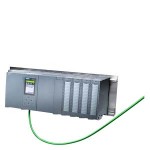
PLC Siemens S7 1500
Modular, scalable, and universally usable system in IP20 level of protection
The system solution for a variety of automation applications in discrete automation
Highest performance with excellent usability
Configura
- GIẢI PHÁP SẠC XE Ô TÔ ĐIỆN NVCharge
- DANFOSS
- NĂNG LƯỢNG TÁI TẠO
- GIẢI PHÁP TÍCH HỢP
- Hệ thống biến tần trung, hạ áp
- Hệ thống cân băng tải
- Hệ thống chuyển nguồn điện tự động ATS
- Hệ thống điều khiển động cơ MCC
- Hệ thống điều khiển phân tán DCS
- Hệ thống điều khiển PLC - Scada
- Hệ thống điều khiển TPS
- Hệ thống giám sát và nhiệt trị than online
- Hệ thống khởi động mềm trung, hạ áp
- Hệ thống UPS
- Tủ điện phân phối MDB & DB, tủ cấp nguồn
- MARECHAL - TECHNOR
- BORRI
- FLENDER
- DURAG
- SOLCON
- SIEMENS
- METSO OUTOTEC
- DỊCH VỤ KỸ THUẬT
Liên hệ
CÔNG TY CỔ PHẦN THƯƠNG MẠI KỸ THUẬT HẢI ANH – HAI ANH JSC
Trụ sở tại TP Hà Nội:
+ Địa chỉ: P301, Nhà D5C, đường Trần Thái Tông, phường Cầu Giấy, TP. Hà Nội, Việt Nam
+ ĐT: (+84-24) 6269 7755
+ Fax: (+84-24) 6269 5556Trung tâm nghiên cứu, sản xuất công nghệ cao Nova Energy:
Lô đất CN1-12B – 1.3, Khu công nghiệp công nghệ cao 1, Khu Công nghệ cao Hòa Lạc, xã Hạ Bằng, Hà Nội, Việt Nam
+ ĐT: (+84-24) 3202 2677Chi nhánh tại miền Trung:
+ Địa chỉ: P1109, Toà A, chung cư Tecco Đông vệ, phường Hạc Thành, tỉnh Thanh Hoá, Việt Nam
+ ĐT: (+84-23) 7383 8886Chi nhánh tại miền Nam:
+ Địa chỉ: Tầng 1, Tòa nhà Gia Thy, 158 Đào Duy Anh, phường Đức Nhuận, Thành phố Hồ Chí Minh, Việt Nam
+ ĐT: (+84-28) 3517 8949
+ Fax: (+84-28) 3517 8950-

Giải pháp sạc xe điện NVCharge có mặt tại Không gian công nghệ cao – Hội chợ Mùa Thu 2025
-

Hải Anh đón tiếp ông Izzi Eicher – Đại diện hãng Solcon (Israel) đến thăm và làm việc tại Nhà máy
-

Hải Anh Nhận Giải Thưởng “Market Expansion Award” tại Innomotics Academy 2025
-

KHÁNH THÀNH DỰ ÁN NHÀ MÁY ĐIỆN GIÓ HẢI ANH TẠI QUẢNG TRỊ
-

Hải Anh Cháy Hết Mình, Gắn Kết Yêu Thương Tại Miền Trung Thân Yêu! ❤️🔥


